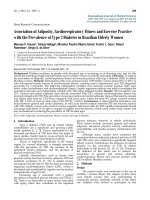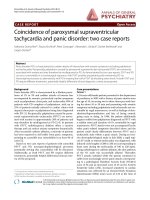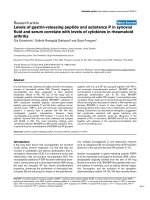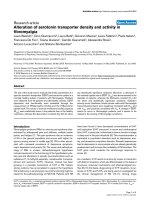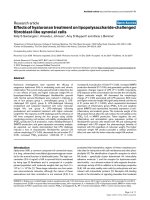Báo cáo y học: "Coincidence of paroxysmal supraventricular tachycardia and panic disorder: two case reports" pdf
Bạn đang xem bản rút gọn của tài liệu. Xem và tải ngay bản đầy đủ của tài liệu tại đây (286.44 KB, 3 trang )
Domschke et al. Annals of General Psychiatry 2010, 9:13
/>Open Access
CASE REPORT
BioMed Central
© 2010 Domschke et al; licensee BioMed Central Ltd. This is an Open Access article distributed under the terms of the Creative Com-
mons Attribution License ( which permits unrestricted use, distribution, and reproduc-
tion in any medium, provided the original work is properly cited.
Case report
Coincidence of paroxysmal supraventricular
tachycardia and panic disorder: two case reports
Katharina Domschke*
1
, Paulus Kirchhof
2
, Peter Zwanzger
1
, Alexander L Gerlach
3
, Günter Breithardt
2
and
Jürgen Deckert
4
Abstract
Panic disorder (PD) is characterised by sudden attacks of intense fear with somatic symptoms including palpitations
and tachycardia. Reciprocally, palpitations caused by paroxysmal supraventricular tachycardia (PSVT) are commonly
associated with anxiety and may therefore be misdiagnosed as PD. As demonstrated by two case reports, PSVT and PD
can occur comorbidly in a chronological sequence, with PSVT possibly precipitating and maintaining PD via
interoceptive processes or, alternatively, with PD increasing the risk for PSVT by elevating stress levels. As both PSVT and
PD require different treatments, potentially helpful differential clinical diagnostic criteria are proposed.
Background
Panic disorder (PD) is characterised by a lifetime preva-
lence of 1% to 3% and sudden attacks of intense fear
accompanied by somatic, particularly cardiac symptoms
such as palpitations, chest pain, and tachycardia: 89% of
patients with PD complain of palpitations, with up to
25% of patients initially referred to cardiac clinics with
atypical chest pain or palpitations being later diagnosed
with PD [1]. Reciprocally, palpitations caused by parox-
ysmal supraventricular tachycardia (PSVT) are associ-
ated with anxiety in approximately 20% of patients and
may therefore be misdiagnosed as PD [2-4]. In patients
with PSVT, radiofrequency ablation offers a curative
therapy and can reduce anxiety symptoms dramatically.
After successful catheter ablation, a minority of patients
has been reported to still suffer from panic symptoms,
pointing to a possible true comorbidity in at least 4% of
cases [5].
Based on two case reports of patients with comorbid
PSVT and PD, neuropsychophysiological processes
potentially driving this comorbidity will be discussed.
Additionally, as both PSVT and PD require different
treatments, potentially helpful differential clinical crite-
ria will be proposed.
Case presentations
Patient 1
A 34-year-old female patient presented to the department
of psychiatry in 2002 with a history of panic attacks since
the age of 18, occurring two to three times per week last-
ing for about 10 to 30 min and presenting with somatic
symptoms including palpitations and tachycardia not ter-
minable by vagal manoeuvres, as well as feelings of dere-
alisation/depersonalisation and fear of losing control,
going crazy or dying. In 1996, the patient additionally
began to suffer from palpitations diagnosed as PSVT with
a sudden onset and duration of 6 h, terminable by vagal
manoeuvres. PSVT attacks were not accompanied by the
other panic-related symptoms described above and the
patient could clearly differentiate between PSVT and a
tachycardic state within a panic attack. During an inva-
sive electrophysiological study in July 2000, a rapid typi-
cal AV nodal re-entrant tachycardia was diagnosed, with
induced cycle lengths of 280 to 330 ms (corresponding to
heart rates during the tachycardia of 180 to 220 bpm).
Using radiofrequency catheter ablation, the slow pathway
of the AV node was successfully ablated. Thereafter,
PSVT attacks subsided while the patient continued to
suffer from increasingly severe panic attacks correspond-
ing to a pathological Hamilton Anxiety Scale (HAMA)
score of 36 and an increased score of 33 on the Anxiety
Sensitivity Index (ASI). Increased sensitivity to cardiac
sensations was reflected by an elevated Body Sensation
Questionnaire (BSQ) mean score of 2.35 at the time of
* Correspondence:
1
Department of Psychiatry, University of Münster, Münster, Germany
Full list of author information is available at the end of the article
Domschke et al. Annals of General Psychiatry 2010, 9:13
/>Page 2 of 3
referral in 2002. Antidepressive pharmacological treat-
ment with mirtazapine (15 to 30 mg) was administered
for 6 months. Additionally, the patient underwent cogni-
tive-behavioural psychotherapy (CBT) (20 sessions)
including psychoeducation about the role of interocep-
tive cues within the vicious circle leading to panic attacks
as well as interoceptive exposure (compare with [6]).
After therapy, the patient was completely free of panic-
related symptoms as reflected by a HAMA score of 0.
Patient 2
A 37-year-old woman was referred to the department of
psychiatry in 2003 with panic attacks since the age of 23,
which were aggravated by stressful life events and lasted
between 15 to 30 min with typical symptoms as described
above including palpitations not terminable by vagal
manoeuvre. In addition, the patient reported palpitations
since the age of 16, starting with two episodes per year
and culminating in four episodes per week with a dura-
tion of 20 s up to 10 min diagnosed as PSVT in the
department of cardiology. PSVT episodes were accompa-
nied by anxiety, but were terminable by a vagal manoeu-
vre, did not imply feelings of derealisation/
depersonalisation or fear of losing control, going crazy or
dying and were clearly distinguishable from the 'newer'
panic attacks. In November 2003, the patient was suc-
cessfully ablated using radiofrequency current (compare
to patient 1) that terminated PSVT symptoms. However,
panic attacks continued to occur with an even increased
frequency of about 1 per day, which corresponded to a
HAMA score of 39, an increased ASI score of 40. Again,
an elevated mean BSQ score of 2.53 in December 2003
mirrored increased interoceptive sensitivity particularly
towards cardiac activity. After cognitive-behavioural psy-
chotherapy (25 sessions) including interoceptive expo-
sure as described above the patient was completely
symptom free after 12 months of treatment and also at a
long-term follow-up (November 2007: HAMA: 1).
Conclusions
The present cases demonstrate that PSVT and PD can
co-occur as two different diagnostic entities. Both
patients could clearly differentiate between PD and PSVT
symptoms: Differential diagnostic clues were that in con-
trast to panic attacks PSVT attacks were not accompa-
nied by symptoms such as feelings of derealisation/
depersonalisation or a fear of losing control, going crazy
or dying. Conversely, panic attacks were not terminable
by vagal manoeuvres. The possibility of true comorbidity
of PSVT and panic disorder thus necessitates reciprocal
inclusion of both nosological entities in the diagnostic
evaluation of the respective diseases.
Given the chronological sequence of onset of the two
comorbid diseases in the present cases, two different neu-
ropsychophysiological interactions of PSVT symptoms
and specific PD symptoms may be postulated.
Firstly, as in patient 1, PD might trigger PSVT as has
previously been shown for ventricular premature beats or
arrhythmias possibly via chronic mental and somatic
stress [7].
Secondly, as in patient 2 and also in patient 1 after abla-
tion, PSVT might initiate or aggravate anxiety states as an
internal cue of panic and anxiety. This latter hypothesis is
in line with anxiety disorder patients exhibiting increased
interoceptive sensitivity, particularly to heart beat [8,9],
as mirrored by elevated BSQ mean scores in both cases
presented here. Also, elevated ASI scores as in both cases
here have been shown to be associated with more accu-
rate heart rate estimation suggesting an interaction of
physiological arousal and state anxiety in interoceptive
accuracy [10,11]. In anxiety disorders, not only has
increased self-report of somatic sensations been
observed, but also a subsequent dysfunctional cognitive
appraisal of these sensations with a significant bias
towards a danger-related and catastrophising interpreta-
tional style (for example, [12,13]). Consistently, self-rated
fears of specific physical and psychological symptoms in
PD patients as measured by the BSQ are primarily related
to the catastrophising idea of having a heart attack [14].
Thus, increased cardiac awareness as precipitated by
PSVT and further influenced by increased anxiety sensi-
tivity may be a factor for the development and mainte-
nance of panic disorder.
Assuming a reciprocal neuropsychophysiological inter-
action between PSVT and PD via either chronic mental
and somatic stress or interoceptive processes, immediate
and focused differential treatment such as radiofre-
quency ablation in PSVT or cognitive behavioural psy-
chotherapy, if necessary in combination with
pharmacological treatment (for example, with serotonin
reuptake inhibitors (SSRI) or noradrenaline and selective
serotonin agonists (NaSSA)) in PD is warranted in order
to possibly avoid the precipitation of the respective other
disorder.
Consent
Written informed consent was obtained from the patients
for publication of this case report.
Competing interests
The authors declare that they have no competing interests.
Authors' contributions
KD contributed to the acquisition and interpretation of data (clinical history
and ratings) and conceived and designed the case report. JD initiated the case
report after treating the patients in a psychiatric/psychotherapeutic setting. PK
performed radiofrequency catheter ablation in both patients, AG was involved
in psychotherapeutic interventions and psychometric description; both
together with GB and PZ contributed to the manuscript with important intel-
lectual content. All authors contributed to drafting the manuscript and gave
approval to the final version.
Domschke et al. Annals of General Psychiatry 2010, 9:13
/>Page 3 of 3
Acknowledgements
This work was supported by the Deutsche Forschungsgemeinschaft (SFB-TRR-
58 to KD, JD and PZ) and the fund "Innovative Medical Research" (IMF) (DO 12
05 08) of the University of Münster Medical School.
Author Details
1
Department of Psychiatry, University of Münster, Münster, Germany,
2
Department of Cardiology and Angiology, and German Competence Network
on Atrial Fibrillation (AFNET), University of Münster, Münster, Germany,
3
Institute of Psychology, University of Münster, Münster, Germany and
4
Department of Psychiatry, University of Würzburg, Würzburg, Germany
References
1. Fleet RP, Dupuis G, Marchand A, Burelle D, Arsenault A, Beitman BD: Panic
disorder in emergency department chest pain patients: prevalence,
comorbidity, suicidal ideation, and physician recognition. Am J Med
1996, 101:371-380.
2. Kadish A, Passman R: Mechanisms and management of paroxysmal
supraventricular tachycardia. Cardiol Rev 1999, 7:254-264.
3. McCrank E, Schurmans K, Lefcoe D: Paroxysmal supraventricular
tachycardia misdiagnosed as panic disorder. Arch Intern Med 1998,
158:297.
4. Kitzlerová E, Anders M, Kautzner J, Dohnalová A: Evaluation of
psychopathology in patients with paroxysmal supraventricular
tachycardia. Exp Clin Cardiol 2007, 12:42-45.
5. Lessmeier TJ, Gamperling D, Johnson-Liddon V, Fromm BS, Steinman RT,
Meissner MD, Lehmann MH: Unrecognized paroxysmal supraventricular
tachycardia. Potential for misdiagnosis as panic disorder. Arch Intern
Med 1997, 157:537-543.
6. White KS, Barlow DH: Panic disorder and agoraphobia. In Anxiety and its
disorders: The nature and treatment of anxiety and panic 2nd edition. Edited
by: Barlow DH. New York, USA: Guilford Press; 2002.
7. Kuijpers PM, Honig A, Wellens HJ: Effect of treatment of panic disorder in
patients with frequent ICD discharges: a pilot study. Gen Hosp
Psychiatry 2002, 24:181-184.
8. Does WAJ Van der, Antony MM, Ehlers A, Barsky AJ: Heartbeat perception
in panic disorder: a reanalysis. Behav Res Ther 2000, 38:47-62.
9. Domschke K, Stevens S, Pfleiderer B, Gerlach AL: Interoceptive sensitivity
in anxiety and anxiety disorders: an overview and integration of
neurobiological findings. Clin Psychol Rev 2010, 30:1-11.
10. Zoellner LA, Craske MG: Interoceptive accuracy and panic. Behav Res
Ther 1999, 37:1141-58.
11. Stewart SH, Buffett-Jerrott SE, Kokaram R: Heartbeat awareness and
heart rate reactivity in anxiety sensitivity: a further investigation. J Anx
Disord 2001, 15:535-53.
12. Clark DM, Salkovskis PM, Ost LG, Breitholtz E, Koehler KA, Westling BE,
Jeavons A, Gelder M: Misinterpretation of body sensations in panic
disorder. J Consult Clin Psychology 1997, 65:203-213.
13. Ludewig S, Geyer MA, Ramseier M, Vollenweider FX, Rechsteiner E,
Cattapan-Ludewig K: Information-processing deficits and cognitive
dysfunction in panic disorder. J Psychiatr Neurosci 2005, 30:37-43.
14. Chambless DL, Beck AT, Gracely EJ, Grisham JR: Relationship of
cognitions to fear of somatic symptoms: a test of the cognitive theory
of panic. Depression Anxiety 2000, 11:1-9.
doi: 10.1186/1744-859X-9-13
Cite this article as: Domschke et al., Coincidence of paroxysmal supraven-
tricular tachycardia and panic disorder: two case reports Annals of General
Psychiatry 2010, 9:13
Received: 18 February 2010 Accepted: 12 April 2010
Published: 12 April 2010
This article is available from: 2010 Domschke et al; licensee BioMed Central Ltd. This is an Open Access article distributed under the terms of the Creative Commons Attribution License ( ), which permits unrestricted use, distribution, and reproduction in any medium, provided the original work is properly cited.Annals of General Psychiatry 2010, 9:13


